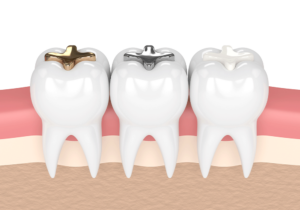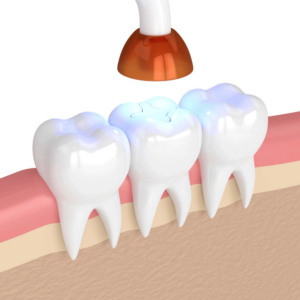Fillings and Sealants
Tooth decay and cavities are both common dental issues. Receiving tooth-colored fillings can restore your teeth and help to prevent simple decay from becoming something worse.
Dental Fillings
A dental filling is used to treat a cavity and is a relatively painless process and can easily be handled at our New Albany office. To perform the treatment, our dentists first numb the area around the tooth, to ensure that you remain comfortable throughout the procedure, and then remove the decayed portion of the tooth to prevent further damage. Next, the empty cavity of the tooth is filled in, where the damaged portion had been, with restoration material that is then shaped and polished to fit seamlessly into your bite.
Tooth fillings are available in a variety of materials, including composite resin (plastic), ceramic (porcelain), and gold. At Netter Family Dental, we work with each patient to decide which type of filling and process would be the best and least invasive option for him/her.

Dental Sealants
No matter how diligently you brush, rinse, and floss, it’s inevitable that some plaque and food will get captured in the deep grooves of a tooth’s chewing surface. At Netter Family Dental, our dentists use sealants to fill those grooves and prevent cavities from forming.
Sealants are made from medical-grade plastic, which guards your teeth against acids and plaques that can cause cavities. Often placed on the chewing surface of molars, sealants are created by painting the tooth with a special material that sticks to its exterior. The process is simple yet proven to be highly effective at cavity prevention.

FAQs
-
How do dental fillings for cavities work?
Cavity and tooth fillings are required when decay leaves holes in teeth. Left unchecked, the decay will continue to spread and damage the tooth’s hard material and eventually the inner pulp and root system. During the filling procedure, dentists clean away decay inside the cavity with a drill. However, because this doesn’t fix the damage that is already there a filling is necessary. The intent of the filling is to replace the part of the tooth that was destroyed by tooth decay. Your dentist will mold the filling to fit the shape of the existing tooth to restore its structural integrity and protect the softer enamel exposed by decay.
-
What types of fillings are there?
There are several types of materials used for teeth fillings including gold, porcelain, silver amalgam (an alloy consisting of mercury mixed with silver, tin, zinc, and copper), tooth-colored plastic, composite resin and glass ionomer. The material used depends on your dentist, the extent and location of your tooth decay and your insurance coverage.
-
Is tooth sensitivity after a filling normal?
When you get a filling, the area around the infected tooth is numbed. You shouldn’t feel anything for an hour or two after your appointment but once the numbing wears off it’s normal to feel pain in your teeth and gums.
More Questions
If you have more questions about dental fillings and sealants, give us a call and we'll be happy to discuss further.

